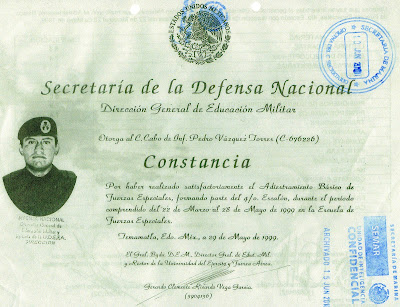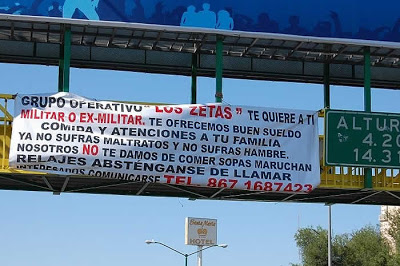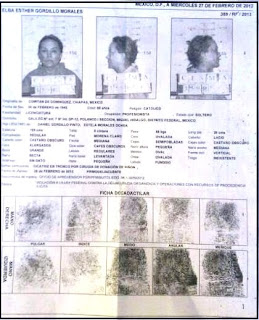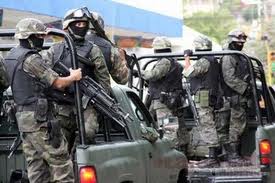A Borderland Beat Contribution from "Tijuano" of Baja CaliforniaJhon Jairo Velásquez Vásquez aka 'Popeye', former boss of sicarios for Pablo Escolar Gaviria and self-confessed murderer of “more or less” 250 enemies, remembers the late 80´s Tijuana as a defiant and extremely dangerous city.
"Tijuana was really dangerous and the biggest risk was the police. One knew that the Mexican police was the world’s most corrupt and at the time i used to visit if you landed with more than 10 thousand dollars in Mexico, police simply made you disappear.”
Popeye summaries in an interview from the maximum security prison of Combita, 110 miles northeast of Colombia´s capital.
He travelled several times to Mexico in the late 80´s as an emissary for Escobar, the former chief of the Medellin Cartel. He remembers Mexico City, the long corridors of the airport and the connecting flights to Tijuana and Ciudad Juarez, where he met with the former boss of the Juarez Cartel Amado Carrillo Fuentes aka “El Señor de los cielos”(The lord of the skies), to coordinate the first shipments of cocaine from South America.
They were other times, he says. Most of the business was handles by the Colombians. Nowadays, more than two decades later it´s the other way around. According to “Popeye”, Mexican mafias seized control of the cocaine industry and bested the Colombians at it.
The rich in the narco business, the rich, rich, rich, are the Mexicans” states Popeye and maintains that the Mexican criminal organizations are also more violent, but less effective than the Medellin Cartel of the 80´s and early 90´s.
“They kill lots of people but they are not as effective as we were in hitting the State structures. Los Zetas have killed many. I feel they are wrong. Killing so many people is craziness, just for nothing. Those 70 immigrants they killed!(In San Fernando, Tamaulipas, in 2010) That are crazy!, says the former hit man that surrendered in 1992 in exchange for a legal agreement for which he is currently serving a sentence of 21 years, which will end next July.
He mentions that at this time in the drug business “The Colombian trafficker is the one with the least profit. The Mexican, without a sweat, without getting wet, crosses 20 or 30 tons of Cocaine through tunnels in the border with USA and profits like crazy”.
“Popeye” considers however, that the alliance between Colombians and Mexicans is indissoluble, because the former control cocaine production in the Andes area, and the late, the routes and entry of drugs to the biggest market in the world, the USA, where, according to “Popeye”, are located the main criminal organizations.
“You´ve never heard of any north American narco-traffic groups, never heard of any property seizures to the Americans, of anyone chasing American narcos nor you hear of anyone shooting at them. They protect their economy. But they do go after Mexican narcos, against Colombians”, he says.
Is that why you say that the biggest cartels are in the USA?
Managed by multinationals of the cocaine distribution. What happens is that they are not violent. You know, the north American infrastructure is not going to hang out with AK-47 weaponry, like the Mexicans do in the street, like we the Colombians did in other times. They are suit and tie mobsters and they aren´t chased.
For “Popeye”-now 50 years old-, the Mexican cartels supremacy over the Colombians began to forge when Escobar established a partnership with “El Señor de los Cielos” in 1988. At the moment the Medellin Cartel was responsible for 80% of cocaine shipments to the US. Escobar whom “Popeye” still calls El Patron(the boss)- was escalating a war against the Colombian State in order to abolish the extradition, and the Drug Enforcement Administration(DEA) was blocking the way for the kingpin´s planes that landed in private runways in Florida.
They had to look for new routes and new allies
According to “Popeye”, with the partnership between Carrillo and Escobar a new cocaine route was opened, one that travelled by sea from the Colombian port of Buenaventura to the Mexican Pacific coasts, where the ships unloaded the drugs to the Carrillo Fuentes Cartel(Juarez Cartel).
“It was a route known as La Fanny for accountancy reasons(That´s how it was named by the Medellin Cartel finance boss, Gustavo Gaviria, cousin and partner of Escobar).
And it was the route that kept Escobar afloat, because after the war with the Colombian State the Americans started seizing planes to El Patron in Costa Rica, Nicaragua, Panama, in all Central America”, recounts Velasquez in the Combita prison courtyard, guarded by two prison guards that brought him from his cell handcuffed and wearing a bullet-proof vest and a armored shield.
He states that the partnership between Escobar and Carrillo was really profitable for both until 1991, when Escobar surrendered to be held at the prison known as La Catedral, which he built for himself in the outskirts of Medellin.
“When we were in La Catedral, Amado Carillo stole 12 thousand kilos of cocaine from Escobar, this was made in alliance with the Cali Cartel, which was at war with us. That´s when the partnership ended”, “Popeye” narrates.
He states that in that era Escobar was “Really bad financially” and thought about starting a war against “El Señor de los Cielos”, but didn´t do it because “it was complicated; we had war with the State, with the paramilitary and with Cali; starting a fourth war against Amado Carrillo…Going to Mexico is complicated. You know, the Mexicans are fucked up, and one said, ok, let´s send 20 hit men from Medellin to Mexico…They would eat them alive in 10 minutes. In those wars you have to be careful”.
According to “Popeye”, with Escobar´s execution in 1993 the drug shipments to Mexico started to be industrialized and the Mexican mafias got a bigger importance in the business: From Carrillo´s cartel to the Sinaloan´s to the Beltran Leyva´s.
The accusations
Even in jail Escobar´s former lieutenant keeps informed via radio, T.V. and the main newspapers of the country which he receive every week of what´s going on in Colombia and the world. He is also up to date in crime news thanks to contact with other inmates despite the strict jail regimen.
He knows of the tens of thousands of deaths that the narco-violence in Mexico left in the past administration and knows some of the main protagonists. He remembers Leyner Valencia Espinosa aka “Piraña”, a Colombian that operated with the Norte del Valle Cartel for Arturo Beltran Leyva, executed by Mexican marines in December 2009. According to “Popeye”, Valencia –captured in Colombia in 2006 and extradited to USA in 2007- started working with the DEA in a Colombian prison and was a key element in attacking Arturo Beltran Leyva´s structure and in finding his hideout.
“Mexican cartels are being attacked from inside Colombian prisons, the accusations is what will finish them. Here the Colombians have nourished Mexican cartels and know them really well”, he states.
He also considers that in this moment Joaquin Guzman Loera aka “El Chapo” is the most powerful drug dealer in the world. And also the richest.
“He´s richer tan Pablo(Escobar), 100 times”, considers “Popeye”, because he profits about 40% of every kilogram of cocaine that his Colombian partners send him top ut in the US streets, and this “Without even touching cocaine, without sweating; he crosses it and profits a ton of money”.
Some consider Chapo Guzman being like Escobar, What do you think of this?
"Chapo” is rich and violent, and he is handsome. But he doesn´t have the criminal mind of Pablo Escobar, he isn´t at Escobar heels in that matter. Pablo Escobar had a vision, taking down the extradition, and “Chapo” Guzman doesn´t have a vision, he has nothing to ask.
He doesn´t have a cause?
No, he doesn´t, exactly, he doesn´t.
He says Escobar and his partners in the Medellin Cartel had as a cause the abolition of the extradition treaty and they finally made it when the handing over of Colombians to be judged by other countries was prohibited in the 1991 Constitution. Even thou this measure was deleted in 1997, four years after the death of Colombia´s most powerful cartel leader.
“We were only about 2 thousand hit men from Medellin neighborhoods and we finished the Republic of Colombia because we hit the four powers: Congress, Executive, Legal and Press. This took 3 thousand victims from the State and we made the State bow down to us”.
Among the victims of the Medellin Cartel we can find former minister of Justice Rodrigo Lara Bonilla(1984); journalist Guillermo Cano and colonel Jaime Ramirez Gomez(1986); attorney General Carlos Mauro Hoyos(1988); colonel Valdemar Franklin Quintero and presidential candidate Luis Carlos Galan(1989), besides 540 police men and decens of citizens that died in attacks with explosives like the one that took down a commercial airliner from Avianca in 1989.
How many men did you kill?
I really…Well i mean…taking account of the deaths is for psychopaths, because I was a professional killer. I am related with the death of 3 thousand people, because that´s what the trial for the Medellin Cartel states; and by my own hand, well maybe about 200, more or less.
And does that give you any kind of remorse, some kind of reflexion?
![]() |
| Escobar's Narco Catedral Prison |
Look, reflexions yes, but when you start combine grays… I paid more grays than rude hookers, like they say, because I was scammed. I, being a bandit, another bandit scammed me, a bigger bandit than me that is the Government, because I was here to pay seven years(in prison) and I will pay 22 years.
“Popeye” was jailed a year when he surrendered for the fist time to justice, in June 1991 alongside Escobar, but he escaped with him and othe hit men from La Catedral prison in July 1992. He surrendered again two months later.
He´s been in the Modelo prison of Bogota, in the Valedupar prison and in Combita, in all of them they have tried to kill him. In the Modelo prison he was put under a contract by the deceased guerilla boss Carlos Castaño........continues..
“I was going to get killed in the showers in the morning, and here, one is naked and soapy and nobody makes it in that situation. I´m small and they were going to unleash on me two beasts, two 22 year old guys with wooden knives; I was told about it”, he says, and adds that with the constant hits against him he opted to change strategies.
He thought that if the mafia wanted him dead and at the same time he was an enemy of the State he wouldn´t make it alive out of prison. In 2005 he started to cooperate with the justice and accused Alberto Santofirmio, a member of the Liberal Party as the mastermind behind the assassination of presidential candidate and also member of the Liberal Party, Luis Carlos Galan. This hit was perpetrated by hit men from Medellin in August 1989.
Popeye´s testimony-who participated in the planning of that homicide- led to a 24 year sentence against Santofirmio. Escobar´s former lieutenant is also a key witness in Avianca´s airliner bombing trial, in which 107 people died in November 1989.
In Exchange for his collaboration with justice, the State protects him. In Combita he feels safe. It´s Colombia´s maximum security prison. “All the Colombian mafia has been around here” he says, amongst them Gilberto and Miguel Rodriguez Orejuela, former Cali Cartel bosses, who were extradited in 2004 and 2005 to the US.
“We are dead”
“How did they finish us?, he asks, and lists the factors that changed the course of a war that at moments looked like an easy win for the cartels: The creation of effective intelligence agencies and of special operation teams, fighting against corruption among security personnel , advice from the US and above all, the rewards.
“The problem with Mafia is treason”, he considers.
Treason?
Yes. How do you end with the Mexican mafia? The “wanted” poster. They have to mention this in the media (ads offering rewards with pictures of the main kingpins), handing out papers, throwing them (from planes).
A rewards politic?
It´s key. Pablo Escobar once told me, when they put us in the “wanted” posters (1989): Pope, we are dead. It´s like in the West: Wanted”, we are dead. The “Wanted” poster is very dangerous for us as bandits, you go to a store to buy a drink and there is your photo, someone sees it in T.V. and knows you are worth 10 million dollars.
“Popeye” knows his life will hang from a thread when he recovers his freedom, in 5 months. He says he´ll try to live a catholic life, “As ordered by God”, but he has lots of enemies: Family members, friends and partners of the more than 3 thousand victims of the Medellin Cartel; former DAS bosses .
The recently disbanded Colombian intelligence agency whose headquarters were attacked by the Medellin mafia with a truck full of explosives in 1989 and the same agency accused by “Popeye” of helping in the homicide of Luis Carlos Galan and bombing the Avianca airliner- and the Ochoa Vasquez brothers, Jorge Luis and Juan Davis, among others.
The Ochoa Vasquez brothers-former Escobar partners who surrendered to justice in 1990 and paid 6 years in prison- accused him of extortion and “Popeye” accuses them of continuing committing crimes and having a partnership with Los Zetas.
What are the odd of you being executed or being let alone when you recover your freedom?
About 80% I will be killed and 20% I make it-he answers with a smile-. That´s name of the game. I´m not stupid. Will I pay 22 years in prison to get out looking for enemies and telling them:”Hey, shoot me here”?, No. I take care of myself and, if a guy comes after me to kill me, then I will defend myself. I´m not suicidal.
“Popeye” states that the Colombian cartels transmitted a lesson to the Mexicans: Violence. But they still need to learn the impact of violence.
“The consequence is that they( the Mexican cartel bosses) are dead, just almost all the Medellin Cartel members are dead”
Why are they dead?
Chapo Guzman is dead-he says-. Soon he will fall, why? Because he depends from human sources and he will commit mistakes. And you know what is the bandit´s problem? The Bandit has a very big problem: The bandit has to be lucky every day, 24 hours a day, not even 23. All the weeks, all the months, and the whole year, and the cops don´t need more than a minute to kill you.
So you thing that sooner or later…?
Chapo is going down he anticipates. And look in these days, in a routine operation, the Mexican marines found Los Zetas boss and killed him.
This is said by a man thay when he walks out of prison will be 80% dead, but he will find a good woman, pretty and austere with whom he plans to share his “small fortune” that remains from his days as hit men boss and which is more than enough to live with modesty, “like middle-middle class”, the rest of his life. That 20% he still has.Note: The following I have added as a focus on the prison that Escobar built for himself in the deal he cut with authorities. ..Paz, Chivis"La Catedral"In 1991, due to increasing pressure to extradite Escobar, the Colombian government and Escobar’s attorneys came up with a creative “deal”: Escobar would turn himself in and serve a five-year jail term. In return, he would build his own prison and would not be extradited to the United State.
The prison, La Catedral, was an elegant fortress which featured a Jacuzzi, a waterfall, a full bar and a soccer field. In addition, Escobar had negotiated the right to select his own guards. He ran his empire from inside La Catedral, giving orders by telephone.
On December 2, 1993, Colombian security forces using US technology located Escobar hiding in a home in a middle-class section of Medellin. The Search Bloc moved in, triangulating his position, and attempted to bring him into custody. Escobar fought back, however, and a shootout commenced.
Escobar was eventually gunned down as he attempted to escape on the rooftop. He had been shot in the torso and leg, but the fatal wound had come through his ear, leading many to believe that he committed suicide, opposed to one of the Colombian policemen having executed him
Excellent video: a narrative tour of La Catedral Source:Proceso






































































